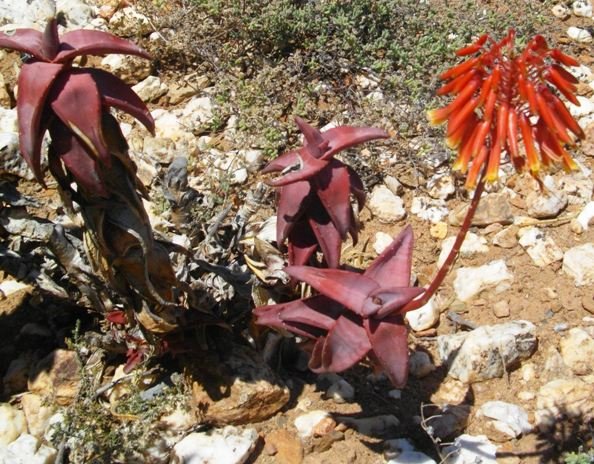Aloe pearsonii red flowers

Author: Ivan Lätti
Photographer: Thabo Maphisa
Aloe pearsonii bears red, brick-red, orange or yellow flowers. The racemes are often unbranched, or the inflorescences may have up to three branches. When the three branches are dichotomous, the racemes usually flower in the same vertical plane. The peduncle is laterally compressed near the base.
The flowers are fairly densely grouped, the raceme short, about head-like. The perianths are cylindrical, slightly enlarged near their tips. The filaments are slightly flattened and pale yellow, the anthers exserted in threes, remaining exserted when the perianths dry.
This aloe is threatened by several factors. These include overgrazing and mining operations in its habitat as well as illegal plant collection, climate change looming large in recent times. The plant's need for an extreme hot and arid climate limits the success with which it can be cultivated in many gardening conditions, the prepared conditions too often ill-suited.
Gardeners are encouraged to plant only such plants as are likely to grow in their area. Those with more enterprise and industry can study and simulate the special conditions that a cherished item will require. Plant species known to be threatened, especially those at risk of becoming extinct in our time, should only be planted by those who have the requisite skills. And no plant growing in nature should ever be removed illegally to do this.
The suggestion is that planting an endangered species should only be attempted by those who have successfully grown non-threatened plants needing similar conditions as the target plant. Obtain help from a professional. Seed or cuttings obtained legally would be a good starting point. And beware commercially traded plants illegally obtained! Make sure of your source. These rules of thumb are likely to increase the survival percentage of "difficult" plants grown by enthusiasts (Frandsen, 2017; Van Wyk and Smith, 2003; Reynolds, 1974; Jeppe, 1969; iNaturalist).

